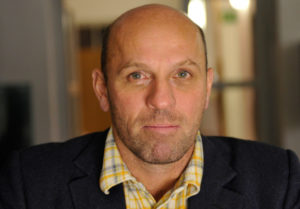
A painting at the centre of a strange multimillion-dollar civil lawsuit filed by a former Canadian correctional officer who owns the canvas was not the work of famed artist Peter Doig, a Chicago judge ruled Tuesday.
In his decision, U.S. District Judge Gary Feinerman said the evidence showed that Doig, whose paintings have sold for more than $20 million, was not in a prison in Thunder Bay, Ont., when the desert landscape was painted in 1976 and sold to the guard.
“Peter Doig could not have been the author of the work,” Feinerman said in his decision, calling it a case of mistaken identity.
The unprecedented battle, closely watched by the art world, involved a claim by Robert (Bob) Fletcher, of Sault Ste. Marie, Ont., who claimed Doig painted the canvas, once valued at more than $10 million.
Doig, who lived in Toronto decades ago, disavowed the work, arguing the acrylic landscape was by a Peter Doige, a man who once spent time locked up in Thunder Bay for a drug offence. Doig said he had never been in the northern Ontario city and only began painting on canvas in 1979.
In an interview minutes after the verdict, Fletcher, 62, expressed his disappointment, but said he remained convinced he owns an authentic Doig.
“A lot of the evidence that we brought forth really wasn’t given much weight,” Fletcher told The Canadian Press.
He said an appeal was possibile, but noted the case had already cost “hundreds of thousands of dollars” of which he said he had paid his fair share.
“Maybe we just can’t afford to move on,” Fletcher said. “It hasn’t been a cheap venture, that’s for sure.”
Among other things, Feinerman noted yearbook photos proved Doig, now 57, was at a Toronto high school and not in the Thunder Bay prison where Fletcher worked.
Doig “absolutely did not paint” the impugned work, which was in fact by Doige, Feinerman found.
The suit had alleged Doig’s disavowal of the canvas – ostensibly to hide his criminal past – potentially cost Fletcher millions.
“I have rarely seen such a flagrant example of unethical conduct in the U.S. courts – nor a case that inflicted such needless burdens on a defendant,” Doig’s lawyer, Matthew Dontzin, said in a statement after the verdict.
“Artists should be grateful to Peter for having the ethical and financial fortitude to fight tirelessly to ensure that justice prevailed.”
Fletcher has said he pursued the claim despite the risk of having to pay hefty court costs.
William Zieske, who represents Fletcher, said he assumed he would see a request for costs in the coming weeks. Zieske said the “perfectly reasoned and reasonable” decision was nevertheless “incorrect.”
“Something is not right,” Zieske said from Chicago. “There is something more going on.”
The dispute dates back 40 years, when Fletcher worked at the Thunder Bay Correctional Centre and also attended classes at Lakehead University. At the school, he met a teenager named Peter Doige, who ended up in jail for possession of LSD and, during art classes at the institution, painted the disputed work.
The 86-centimetre by 105-centimetre canvas, which depicts a desert scene with a pond, is signed “Pete Doige 76.” Fletcher bought the painting for $100 as a way of helping Doige.
Five years ago, one of Fletcher’s friends said the canvas was by Doig. That spurred Fletcher to do some digging, which, according to his claim, turned up “uncanny convergences:” Both Doig and Doige were born in the 1950s in Scotland; Doig’s family immigrated to Canada when he was a child; and he has admitted to having dabbled in LSD as a teen.
Fletcher and Chicago-based Bartlow Gallery alleged Doig and his agents “wilfully and wrongfully interfered” with their efforts to sell the painting. Doig called the lawsuit a scam. The artist, who splits his time between Trinidad and London, also denied ever being in prison.
Marilyn Bovard, of Hinton, Alta., said in court filings that she believed her brother, who died in Edmonton in February 2012, painted the scene that appears to be from an area in Arizona where their mother lived.
Fletcher said he’s convinced Doige wasn’t the artist.
– with files from The Associated Press